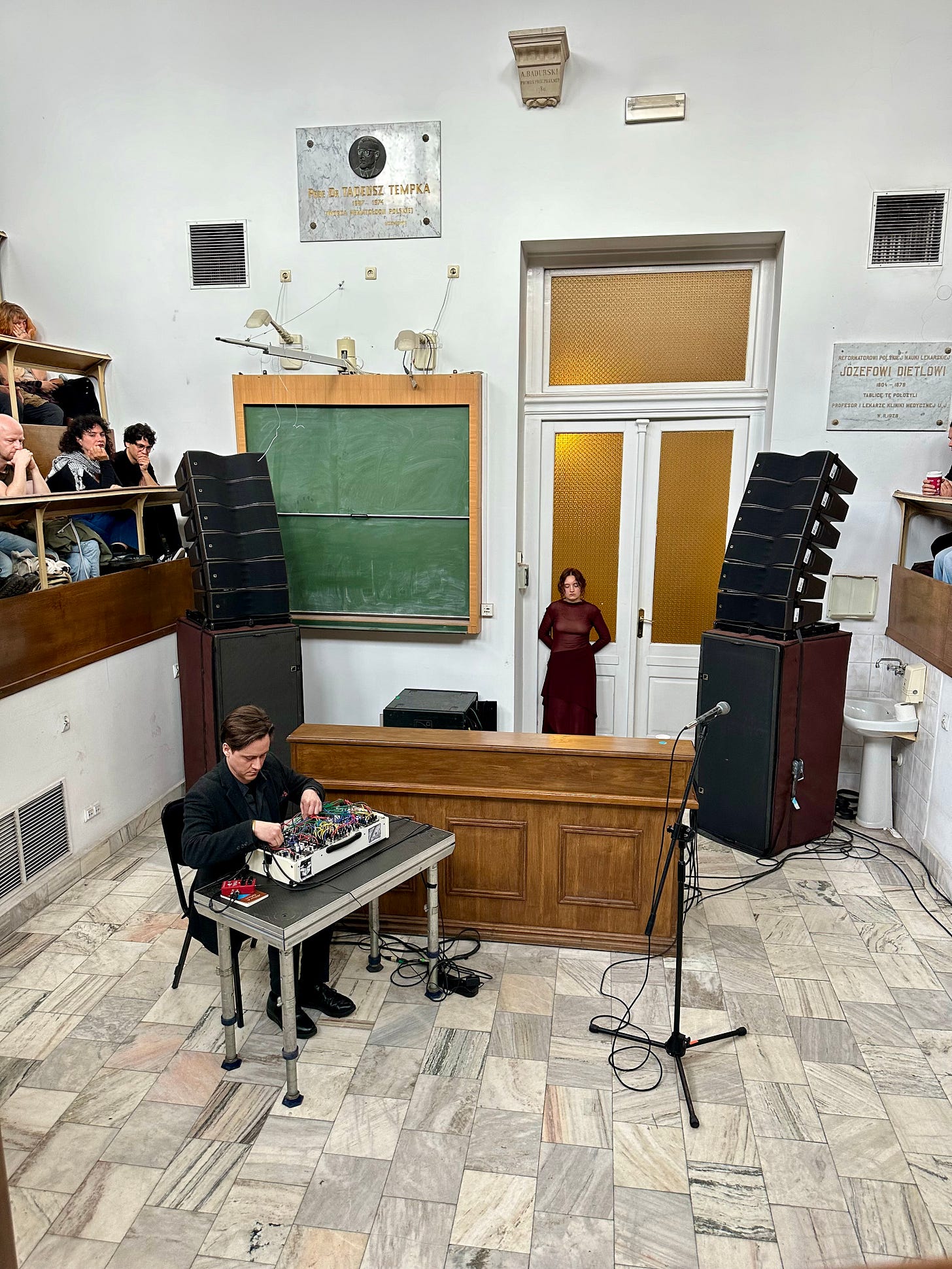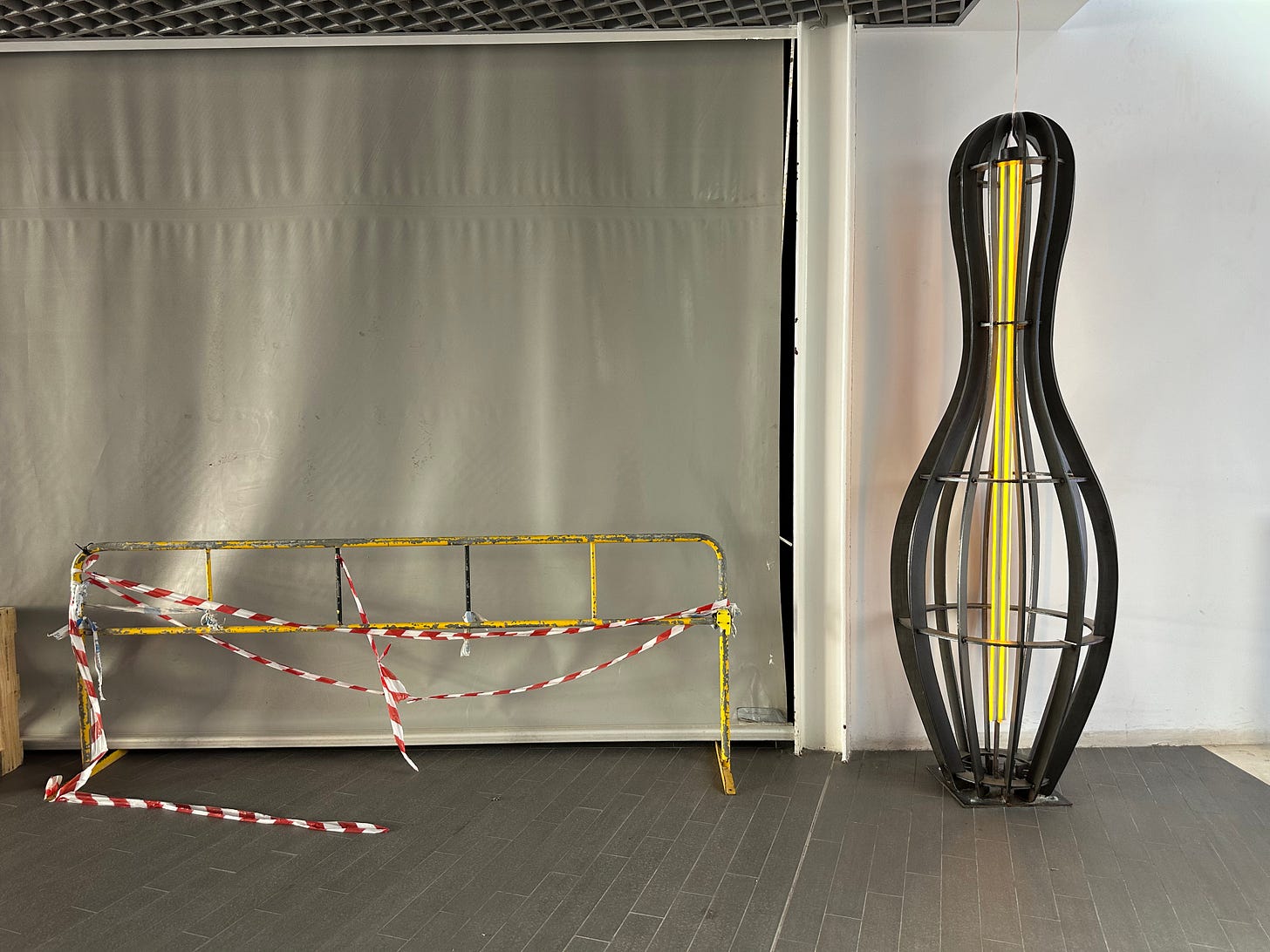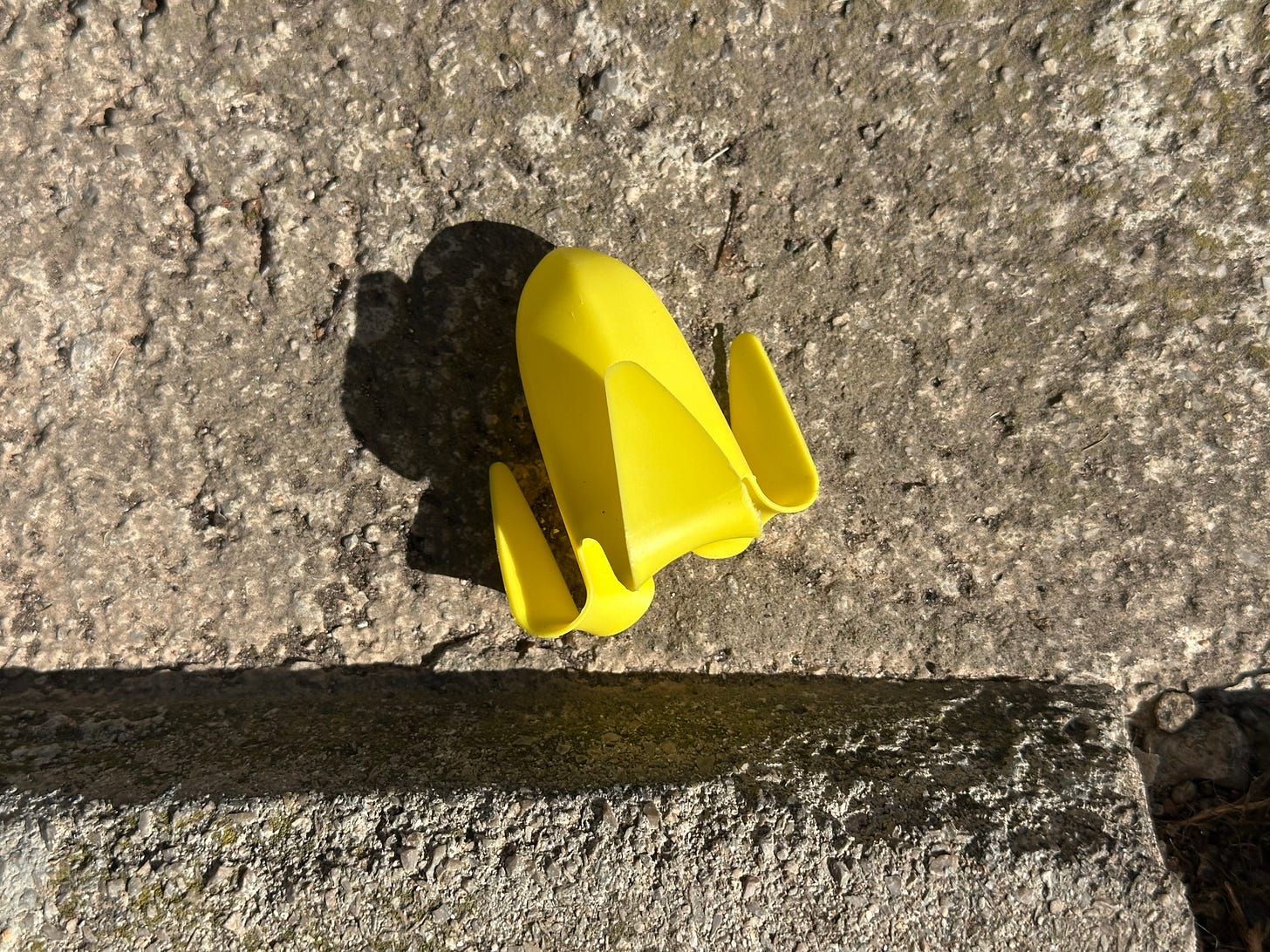FR 121: Serious Symptoms
New music from Lindstrøm, Qasim Naqvi, Purelink, Heinali & Andriana-Yaroslava Saienko, and more
I have a bad feeling about the way things are headed. Trump and his lackeys (and his puppetmasters, like Vought) want a confrontation, and they’re doing everything they can to force one, inventing emergencies as a pretext to invade Los Angeles. Trump is threatening to arrest the elected governor of California; cops are shooting reporters with rubber bullets. The administration is trying to paint legal protests as an “insurrection,” when the only insurrection is the one that began on January 6, 2021 (or even earlier!), and continues to this day. (RFK, meanwhile, is paving the way for a widespread bacterial insurrection; here’s someone, apparently, who watches The Last of Us and thinks the cordyceps are the good guys.) With the mad king’s birthday parade coming up this weekend, we could be arriving at a very ugly inflection point. They will fail in the long run—the question is: how long?
Meanwhile, on other sides of the world, Israel’s genocide of the Palestine people continues unchecked, while Russia continues its imperialist and illegal attack on Ukraine. To name just two of the most egregious assaults on international law and human dignity currently playing out around the world, with no end in sight.
I always hesitate to post things like this; this is a music newsletter, after all. But I think it’s important that we not become passive or complacent; simply acknowledging the magnitude of the crisis is the least any of us can do. And some of the music I write about directly invokes ongoing events, whether it’s Heinali and Andriana-Yaroslava Saienko’s use of Ukrainian folk music to address Russian war crimes, or Qasim Naqvi and Moor Mother’s elegiac portrait of civilizational collapse.
Fortunately, I also write about some happy music this week, like the new album from Lindstrøm, which boosted my mood in a way I really needed. UK group caroline offer a take on indie rock that’s trippy and cryptic; Purelink facilitate ambient introspection; Sandro Perri and Adam Marshall submit to improvisational dub-techno drift; and Jake Muir zones out to the sound of European church bells. There’s plenty more, too, including club music from Ehua, Impèrieux, and Al Wootton.
This issue of the newsletter is free for all to read, thanks to the generosity of paying subscribers; read on for all those releases and more.
Paid subscriptions are $5 a month or $50 a year; perks include exclusive playlists for chilling and clubbing (now available on Deezer as well as Apple Music and Spotify); the ongoing Mixes Digest series; and full access to the archives, including interviews with FaltyDL, Penelope Trappes, music critic and runner Ben Ratliff, Longform Editions head Andrew Khedoori, Seefeel’s Mark Clifford, and more.
Record of the Week
Heinali & Andriana-Yaroslava Saienko: Гільдеґарда (Hildergard) (Unsound)
Heinali and Andriana-Yaroslava Saienko’s Unsound Kraków performance last year was the kind of thing you don’t easily forget. It was a Morning Glory show, one of the ones you have to wake up early for; they performed in the operating theater of a former medical college, on a small circle of ground ringed by risers, with the audience looking down from what could feel like a vertiginous angle. It’s one of Unsound’s most stunning venues, one that generates a slight (if unconscious) frisson between the precariousness of the seating arrangement, combined the odd feeling of spying on the artists—as if we, the audience, were a kind of crowd-sourced panopticon—and the soothing ambient character of most of the Morning Glory material. That frisson felt electric in the Ukrainian duo’s performance of two pieces adapted from Hildegard von Bingen, the 12th-century composer and mystic. Heinali played modular synthesizer, focusing on slowly shifting and minutely modulating drones—something he’s been doing in a “classical” context for a while; see, for example, his 2020 album Madrigals—while Saienko sang, utilizing a vocal technique, avtentyka, rooted in pre-modern village life. (Maria Sonevytsky’s Pitchfork review of the album very helpfully explains the cultural significance of the avtentyka style in post-Soviet—and, now, mid-invasion—Ukraine.)
Hildegard’s music, a music of unearthly grace, can often be delivered with careful restraint; see, for instance, the 1982 album A Feather on the Breath of God, by the choral group Gothic Voices. Such is not the case here. Saienko’s singing is fierce and cutting; rising in volume and intensity, ascending scales as though climbing a circular staircase, she attacks her notes, swooping up in pitch—in concert, I imagined scythes felling fields of wheat. It’s not just beautiful; it’s harrowing, channeling untold depth of ecstatic pain. When she wasn’t singing—and long portions of both of the 20-minute pieces they played, which are replicated on this album, are given over to Heinali’s extended synthesizer cadenzas—she stood in a corner of the “stage,” near the sink, eyes closed and head bowed, an expression of unfathomable intensity on her face. Even in silence, she was incandescent.
Гільдеґарда (Hildergard) is the duo’s studio recording of that same material, and while I don’t know what it might be like to hear the music for the first time here, without the accompanying memories of a show in which it felt like I had been pierced by a beam of light, it feels like a gift to have this music out in the world, available to all and sundry, a small packet of rapture, or spiritual ruin, for whomever might need it at any given time. “O Ignis Spiritus” is a reverberant plainchant drone as dramatic as scaling a mountain; “O Tu Suavissima Virga” is it opposite, Saiekno’s voice as quiet as a mother singing to her child, over a gravelly pedal tone so unobtrusive you forget it’s there at all—until, halfway through the song’s 20-minute run, she launches into the ragged fury of the avtentyka style, and the air seems to turn blood red.
It is, of course, impossible to hear this music outside the context of the Russian invasion of Ukraine; it is a conduit for generations of ancestral pain that has perhaps never been more acute than it feels right now. That feeling comes to a head on the digital bonus track “Zelenaia Dubrovonka,” a Ukrainian folk lament framed as rural idyll: “Green oak tree, why did your leaves rustle so early?” In a note accompanying the album, Heinali imagines the shaking branches as moved not by the wind, but by Russian missiles slicing through the air overhead. (One such missile landed not far from Heinali’s own studio in Kyiv.) There’s even more wildness in Saienko’s voice here, as she surges up the scale over Heinali’s smoldering drones; it’s an expression of pain, but I hear something else in her carefully controlled unruliness: defiance.
Albums
Lindstrøm: Sirius Symptoms (Feedelity)
A funny thing happened when I got sent the promo for Hans-Peter Lindstrøm’s new album. Oh, I don’t know if I’m really in the mood for peppy, feel-good synth disco right now, I thought. I didn’t remember his last album, 2023’s Everyone Else Is a Stranger, with any clarity, though I vaguely recalled it sounding much like Lindstrøm’s music always had. Well, perhaps there was a time when I didn’t think I needed any more of that stuff in my life, but I’m happy to have discovered that I no longer feel that way; by the end of my first spin through Sirius Symptoms, I was hooked. (And I’ve since gone back to Everyone Else Is a Stranger and realized that it’s pretty great too. Maybe I was just in a bad mood in 2023?) True, there may not be anything here that you haven’t heard from Lindstrøm before, but the synths feel particularly buoyant, the drums especially crisp, the chord changes even more heartstring-tugging than usual. The sound is dry and precise. There’s very little reverb; every sound stakes out its own corner of the spectrum. Shorter track times suit the unerringly punchy hooks. Perhaps the biggest shift might be its largely electronic feel, with an emphasis on drum machines and even house beats. “These Are a Few of My Favorite Strings” boasts the bump and swing of NY garage; “Thousand Island Man” is straight-up acid. (Has Lindstrøm ever done acid before? I sure don’t recall any.) Of course, with Lindstrøm, the familiarity is part of the pleasure, but one track in particular gave me something like deja vu: “Moo)n.” Finally, I put my finger on it: Something about the filliping little synth riff reminds me of his pal Todd Terje’s “Snooze 4 Love.” Lindstrøm’s song isn’t a cover or even an homage, but there’s a kernel of Terje’s song in there. I like that; it reinforces the sense that Lindstrøm’s music is part of a long, ongoing conversation. I dipped out for a while, but right now, it’s got me rapt.
caroline: caroline 2 (Rough Trade)
caroline 2 is a puzzle. What kind of music is this? It’s indie rock, in the broadest terms; more narrowly, it feels of a piece with certain strains of contemporary British indie that come at the genre from an oblique angle, defamiliarizing certain givens, reframing assumed truths. But caroline are sleeker than the current wave of UK post-post-punk. Their Coldplay cover (simply titled “Coldplay cover”) is not arch or ironic; the first half sounds like a campfire singalong, and then it twists, assisted by what sounds like bass clarinet and a ribbon of Auto-Tune, into something approximating Gastr del Sol. I hear other unexpected influences flitting through the music, too: The way someone sings “of this ti-ime,” on “Song two,” reminds me of Shudder to Think’s “Day Ditty.” The cracking falsetto of “When I get home” reminds me, I think, of 764-Hero?
On early listens, I somehow got it into my head that caroline are a duo, so at first I was confused by the abundance of sounds and voices and ideas all wrestling for space in the mix, albeit extremely gently. The opener, “Total euphoria”—it sounds like what it’s called—has what feels like about seven different guitar parts, all playing out of sync, over a tumbledown drumbeat that’s also out of sync. It’s exhilarating. I found out later that there are like seven people in the band (I’m not going to fact-check that, but suffice to say, there are a bunch of them), which perhaps explains the general tumult. But now another contradiction rears its head: For a band with such ample ranks, caroline’s music is remarkably clean, neat, dulcet—even when there are scads of different guitar parts playing at cross purposes, and a shrieking violin triggering an explosion of fuzz bass. This might be the most quietly experimental album I’ve heard this year. On the surface, it masquerades as a pleasantly atmospheric indie-rock record with emo overtones. But underneath, termites are at work, burrowing mazes.
Qasim Naqvi: Endling (Erased Tapes)
Qasim Naqvi’s Endling is steeped in tragedy: It’s set at the end of the (human) world, an elegy for the very last of our species—in biological terms, an endling, a term coined in a 1996 article in Nature. But there is nothing maudlin about these contemplative, slow-moving pieces for modular synthesizer, which linger over the ruined scenery with cinematic poise. It’s framed as a narrative piece, each of its eight tracks a chapter “following this human through the crumbling landscape of the future, that was now being overtaken and absorbed by the natural world.” I’m not sure I follow a distinct storyline, but I’m captivated by the shifts in tone and energy: In just the first three tracks, we go from the exploratory, slow-moving melodies of “Fires” to the pulsing cosmic arpeggios of “Beautification Technologies” (in another life, one where humans didn’t go extinct, it could have been an ebullient Lindstrøm song) to the grainy, blown-out radiance of “The Glow,” one of the most soothing drone tracks I’ve heard this year. The storyline comes to the fore on “Power Down the Heart,” in which Moor Mother plays the part of an expiring AI relaying a final report to our doomed human protagonist. There’s more than a whiff of Roy Batty’s “tears in rain” monologue: “I’ve seen so many things/Babies taking their first breath/Children laughing/Crying/Their innocence,” she begins, her murmur almost unintelligible, before the scene darkens. “I’ve seen so much/The failures/The demise… Been a witness of empires crumbling/I’ve seen financial institutions crumble/Laws crumble/Humanity crumble.” Smudged nearly opaque with effects, it nevertheless feels like a mirror. That the track that follows, “Plastic Glacier,” is so unspeakably beautiful feels almost like a grace we don’t deserve.
Jake Muir: Campana Sonans (Enmossed)
Church bells are part of the rhythm of daily life in Europe. I don’t mean for that to sound quaint, or exotic—it’s just a quotidian fact. Sometimes it can be a burden: I remember staying with friends in Kreuzberg who lived so close to the neighborhood bell tower that hungover Sunday mornings were literal agony. (I feel fortunate to live just far from our own neighborhood church—originally erected in the 14th century—that the bells make for pleasant atmospheric color, when I notice them at all, rather than a nuisance.) Jake Muir was struck by the omnipresent soundtrack of Berlin’s bells when he moved to the German capital in 2019, and as he traveled across Europe, he began gathering recordings wherever he went; Campana Sonans is his interpretation of their diffuse background din, spread across two side-long pieces—the Berlin-specific “Erzklang” and the London-focused “Changes.” As documentary pieces, these are both subjective and expressive, plunging the bells into a shifting matrix of street noise, birdsong, and abstracted electronic processing; sometimes the bells come to the fore, their attack crisp, their tones unaltered; elsewhere, they fade into the bassy blur, metallic glints cutting through darkness, and coppery drones pitched the reddish hue of the sunset on a humid August night. Where “Erzklang” is all foggy drift, “Changes”—based on a methodical technique utilizing multiple tuned bells—zeroes in on the clean lines of repeating patterns and the voices of the bell ringers as they shout cues. Hypnotic doesn’t begin to describe it.
Purelink: Faith (Peak Oil)
I had the pleasure of interviewing Purelink—the trio of Akeem Asani, Tommy Paslaski, and Ben Paulson—for Pitchfork not long ago. What struck me the most, over the course of our hour-and-change conversation, was the way their project resulted from a mixture of intention and accident. They gave the impression of having the idea of a sound in their heads, then encountering something very much like that sound out in the real world—in the music of people like Huerco S. and Ulla, for instance—and, finally, figuring out how to make their ideas a reality, and being surprised along the way. (The other big subtext of the conversation: the importance of community in giving shape to their sound.)
Faith very much sounds like the work of artists in exploratory mode; they’ve started from the shirred ambient dub of their Peak Oil debut and plunged further into the swirl. It’s a profoundly low-key record on the surface, where not a lot seemingly happens, but the more deeply you listen, the more small, shimmery details float to the surface, like the tendrils of guitar in “Rookie” or the woozy triplet rhythms of “Kite Scene.” The whole album is more pulse-driven than I initially realized, in fact; it’s just that the drums (particularly on “Yoke” and “Circle of Dust”) are so deeply submerged as to pass almost undetected unless you’re listening for them. But that’s where the secret to a lot of this stuff lies, despite its seductive textural appeal and slightly soporphic tonal range—just listen to the way the dub delay pulls away from the pulse on “Circle of Dust,” and little offbeat accents flicker across the stereo field before vanishing into the ether. You’re never quite sure what you’re hearing. In this, they’re masterful illusionists.
Ehua: Panta Rei (3024)
London-based Italian musician Ehua’s debut album has the small hours written all over it. She works with a mix of styles—house, broken techno, drum & bass, trip-hop—and most tracks feel like hybrids of at least two of them. Case in point: “Amarena,” a slinky fusion of downtempo and dnb that reminds me of classic Lamb. It’s the distinctive palette that holds it all together: dry, woody drums; sublow bass balanced by the occasional acoustic-bass highlights; woozy, watery synths to fill in the empty spaces; and, above all, Ehua’s voice, a downcast murmur that she double-tracks (and occasionally backmasks) and spreads across the stereo spectrum, lending the whole record its soulful character. There are a couple of proper bangers here, like the fleet, rolling techno of “Aria,” but mostly Panta Rei sounds to me like a late-night soundtrack for coming home and staying up.
Marc Melià: Pièces Monophoniques (Vlek)
In a landscape of infinite possibility, sometimes taking away options is the most productive path. I’ve long been a fan of albums made with a single synthesizer; I wrote about the genre, if that’s what you can call it, for Pitchfork back in 2017, highlighting records made with the Korg MS-20 (Simon Haydo), Korg Mono/Poly (Cloudface), Korg Poly-800 (Benjamin Brunn), and Casio CZ-5000 (Satoshi & Makoto). That same year, Marc Melià offered his own contribution with Music for Prophet, crafted on a Dave Smith Instruments Prophet ’08, a modernization of the classic Sequential Circuits Prophet-5. Now the Brussels-based Mallorcan composer returns with Pièces Monophoniques. Composed and performed entirely on the MFB Dominion 1, it doesn’t necessarily sound monophonic, but that’s the whole point. There are no overdubs and no poly-tuned oscillators; instead he uses rapidfire arpeggios and delays to create the illusion of polyphony (one track is even called “Illusions of Polyphony”), or filter resonance to create overtones (“Resonances”). There’s a fetching naiveté to some of the standout tracks, like “Octus” and “Overture,” in which fluid motion and a hint of reverb serve to paper over the copious empty spaces; elsewhere, as on “Subtracting the Superfluous,” intricate chords progressions and pitch-wheel accidentals lend a touch of the baroque. The operative philosophy is right there in the title of track 3: “In Simplicity We Trust.”
EPs
Adam Marshall & Sandro Perri: Uniquity (self-released)
Berlin-based Canadian musician Adam Marshall, proprietor of the great label New Kanada (2006-2014, RIP) was recently back in Ontario to play some shows with Sandro Perri, a shape-shifting artist whose many projects (Polmo Polpo, Glissandro 70, Off World) have run the gamut from ambient surf to Balearic minimalism to an incredible longform Arthur Russell tribute. Perri’s solo albums under his own name—2011’s Impossible Spaces, 2018’s In Another Life, 2019’s Soft Landing—are some of my favorite singer-songwriter records of the past 15 years. (There’s also his great, under-heralded Off World project, a collaborative affair with Lorenz Peter, that reminds me of a woozier Lifted, maybe.) Uniquity is a single 23-minute track, recorded live to two-track tape in rehearsal, with Marshall credited with samples and MFB Tanzbar, and Perri on Pearl Syncussion and “faders.” It plays out something like a dub techno megamix; an opening passage of glistening chords over a dusty drum track and sinewave bass turns more spacious and percussive six or seven minutes in, as the chords fall away and a chorus of robotic crickets rises in the background. They go on like that, adding and removing, teasing fresh sounds into the mix and wiping them clean, fingertips glued to the effects pots. Sometimes, when fragmentary vocal samples drizzle over dry drums and oblong clanks, I hear echoes of classic Perlon. It’s a real trip, best absorbed in its entirety—though for DJs and impatient people, select highlights have been edited down into four short bonus tracks.
Impérieux: Fena EP (Hessle Audio)
A few months ago, I wrote about Bulgarian producer Impérieux’s Rezil EP, on Stefan Goldman’s Macro label (FR101), whose chunky beats and microtonal synth work variously reminded me of Four Tet, Hagop Tchaparian, and Aleksi Perälä. His new Fena EP is even wilder. No mystery why this turned up on Hessle: On the title track, the garage-inflected drums kick like a mule in a field of bees, while a succession of incredibly unhinged synth squiggles pushes the track further and further off its axis—in its killer combination of heavy groove and sheer weirdness, it’s Hessle to a T. “Sickomode,” riding an incredibly satisfying bass-and-drums rollercoaster and nagged by insect-like riffs, is nearly as haywire; “Saat” boasts a smoother groove and softer synths, but the cut-up spoken-word vocals (no idea what language that is) and barking dogs make for nicely (if alarmingly) psychedelic interruptions. He slows down and chills out on the closing “Cawuso,” an eerie, skulking take on deep house that reminds me, faintly, of Pépé Bradock, Axel Boman’s “1979,” Isolée, and other examples of the genre that manage to be immersive and slightly unsettling all at once.
Al Wootton: Rhythm Archives (Trule)
For electronic musicians, there are few playgrounds quite as inviting as the Melbourne Electronic Sound Studios and its enviable collection of synths and drum machines. Al Wootton took advantage of a recent trip there by recording a bunch of vintage rhythm boxes, then taking the files home and dubbing them into these eight drum-forward tracks. From the record’s description, it sounds like Wootton recorded not just individual drum hits but preset rhythms, which would explain titles like “Slow Rock,” “Foxtrot,” and “Shuffle,” but don’t expect any home-organ kitsch here: Suffused in clammy reverb, overlaid with ominous vocals, and tied up in contorted knots, these tracks are way more Cabaret Voltaire meets On U Sound than Space Age Bachelor Pad Music—dank industrial-dub drum workouts that carve labyrinthine paths through near total darkness. They also bang, whether that’s the slow-motion chug of “Beguine,” with its overpowering kicks, or the tight son clave patterns of “Bajon,” which sounds like a whisper-soft take on Errorsmith’s “No Ice.” Pretty sure that playing the two tracks together could cause walls to crumble.
Gold Panda: “Plain Sailing” (self-released)
A delightful little summer trifle from Gold Panda, released as a Bandcamp loosie last week. There’s barely anything to it—just a one-bar loop of watery piano, a boom-tick house beat, and the occasional tuft of trumpet. But it strikes the perfect note of dewy-eyed bittersweetness, a la Superpitcher or Smallville, with a smidgen of kitsch that’d have it right at home on Studio Barnhus or Pampa.
Balmat News
Stephen Vitiello with Brendan Canty and Hahn Rowe: Second (Balmat)
Last week, we finally released this exceptional album from microsound/lowercase veteran Stephen Vitiello with Brendan Canty and Hahn Rowe. I’ve written a ton about the record and even interviewed Stephen for the newsletter so I’ll let the music speak for itself. I hope you enjoy it as much as I do.
Patricia Wolf: Hrafnamynd (Balmat)
Here’s another special one. Patricia Wolf’s debut album, See-Through, is one of the most beloved records on the label; now she returns with the soundtrack to Edward Pack Davee’s Hrafnamynd, an unconventional autobiographical documentary about Iceland, memory, and ravens. This time, Wolf worked primarily with the UDO Super 6 synthesizer, once again attaining a rare combination of melody and ambience. It’s out July 11; we even made merch.
Two Mixes by Me
Philip Sherburne Presents Claustrephilia
A couple Fridays ago, I had the pleasure of playing a 4-hour-plus set at Es Claustre, a fantastic open-air space in the center of Mahón’s historic marketplace. (It was once a cloister—hence the name.) I hadn’t played a club set in a long time, and I wanted to make people dance; I also figured it would be a genre-agnostic crowd, rather than a crew of committed heads. So I went pretty heavy on the classics (Justus Köhncke’s “Timecode,” Axel Boman’s “Purple Drank,” Lindstrøm’s “I Feel Space,” even Audion’s “Mouth to Mouth”), peppered with recent gems (Paramida’s “Devil’s Destination,” Treasure Island’s “Visione”) and leftfield faves (MMM’s “Qué Bárbaro,” Shinichi Atobe’s “Dub 5”). Despite a bounty of “big” tracks, I feel like it flows quite nicely—and the climax is nothing if not energetic.
The Beatportal Residency: Balmat
Twelve or thirteen years ago, when I lived in Berlin, I actually edited Beatportal, Beatport’s blog, so it’s kind of funny that they recently selected Balmat as their label of the month. To accompany the feature, I put together an hourlong ambient mix that approximates the label’s sound, featuring tracks from Le Motel, Whatever the Weather, Colombian Drone Mafia + Gibrana Cervantes, Jo Johnson, and more.
That’s it for this issue—thanks for reading!













I saw caroline perform at Big Ears Fest (2024) As mentioned, there were at least 7 people--if not more. With the aid of the stage crew and audience they took the traditional stage set up and dragged it into the middle of the space, moved out the chairs and created an in-the-round (on the floor) experience. I WAS a campfire! and it was wonderful.
thanks for sharing your thoughts, Philip, and always the great new music! No Kings day around the globe, Saturday, June 14 -- everyone get yourself out there!